The high performance carbon fiber precursor market is expected to grow from USD 717.5 million in 2025 to USD 2,288.8 million by 2035, advancing at a CAGR of 12.3%. Breakpoint analysis highlights critical thresholds in market expansion where growth momentum shifts due to technological advancements, production capacity scaling, and adoption across end-use industries. Between 2025 and 2028, the market experiences an initial breakpoint as early adoption in aerospace, automotive, and wind energy applications drives revenue acceleration. This phase reflects the transition from niche usage to broader industrial integration, with demand increasing for lightweight, high-strength composite materials that enhance fuel efficiency, structural performance, and sustainability.
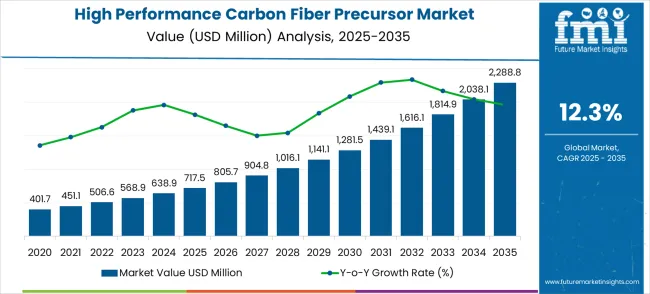
From 2028 to 2032, the market reaches a second breakpoint as production capacity expands and supply chain efficiencies improve. During this period, economies of scale and decreasing precursor costs make high performance carbon fiber accessible to additional sectors, including sports equipment, infrastructure, and industrial machinery. Innovation in precursor formulations and process technologies further strengthens adoption.
The final phase from 2032 to 2035 shows a steady growth trajectory, reflecting maturation and market stabilization as most target industries have integrated carbon fiber composites into their core operations. Breakpoint analysis underscores the importance of aligning investment, production, and R&D strategies with these critical market thresholds to optimize growth, capture emerging opportunities, and maintain a competitive edge throughout the decade.
| Metric | Value |
|---|---|
| Estimated Value in (2025E) | USD 717.5 million |
| Forecast Value in (2035F) | USD 2,288.8 million |
| Forecast CAGR (2025 to 2035) | 12.3% |
The high performance carbon fiber precursor market is segmented across aerospace and defense applications (38%), automotive lightweight structures (27%), wind energy and renewable sectors (16%), industrial machinery and sporting goods (11%), and specialty applications including electronics and medical devices (8%). Aerospace and defense dominate adoption due to the demand for lightweight, high-strength materials in aircraft and defense equipment. Automotive applications are expanding with the push toward electric vehicles and fuel efficiency. Wind energy sectors utilize carbon fiber precursors for turbine blades requiring superior strength-to-weight ratios. Industrial machinery and sporting goods benefit from enhanced durability and performance. Specialty applications focus on medical devices, robotics, and high-end electronics that require precision-engineered, lightweight structural components. Key trends include oxidation-stabilized precursors, bio-based alternatives, and improved spinning technologies. Manufacturers are innovating with higher tensile strength fibers, low-defect production methods, and energy-efficient processing. Growth is driven by aerospace modernization, EV adoption, and renewable energy expansion.
Collaborations between precursor producers and end-use manufacturers enable customized, high-performance solutions, supporting global market expansion.
Market expansion is being supported by the increasing global demand for lightweight and high-strength materials and the corresponding shift toward advanced composite solutions that can provide superior mechanical properties while meeting industry requirements for weight reduction and performance enhancement. Modern aerospace and automotive manufacturers are increasingly focused on incorporating high-performance carbon fiber precursors to develop next-generation composite materials that can satisfy demanding operational conditions while providing competitive advantages in fuel efficiency and structural performance. Carbon fiber precursor's proven ability to deliver exceptional strength-to-weight ratios, thermal stability, and design flexibility makes it an essential raw material for advanced composite manufacturing and high-performance applications.
The growing emphasis on sustainable transportation and energy-efficient solutions is driving demand for high-quality carbon fiber precursors that can support the development of lightweight components for electric vehicles, renewable energy systems, and advanced aerospace platforms. Manufacturer preference for materials that combine performance excellence with processing reliability is creating opportunities for innovative precursor implementations in both established and emerging composite applications. The rising influence of defense modernization programs and space exploration initiatives is also contributing to increased adoption of premium carbon fiber precursors that can provide mission-critical performance characteristics for specialized applications.
The high-performance carbon fiber precursor market represents a compelling growth trajectory, expanding from USD 717.5 million in 2025 to USD 2.29 billion by 2035 at a robust 12.3% CAGR. As aerospace manufacturers prioritize weight reduction for fuel efficiency, automotive OEMs transition to electric vehicles requiring lightweight materials, and defense applications demand superior strength-to-weight ratios, carbon fiber precursors have evolved from specialized materials to strategic enablers of next-generation manufacturing.
The convergence of aerospace recovery post-pandemic, automotive electrification mandates, space exploration investments, and defense modernization programs creates unprecedented demand momentum. Advanced precursor technologies offering enhanced mechanical properties, processing reliability, and cost-effectiveness will capture premium positioning, while geographic expansion into high-growth Asian markets and capacity scaling will drive volume leadership. Regulatory support for sustainable manufacturing and material traceability provides structural tailwinds.
The high-performance carbon fiber precursor market is expanding due to growing demand for lightweight, high-strength materials across multiple industries. PAN-based precursors dominate the market with approximately 65% of the market share, offering tensile strength of 3.5–4.5 GPa, thermal stability up to 300°C, and high carbon yield (around 55–60%), making them ideal for advanced composite applications. Aerospace leads the application segment with roughly 30% of the market, reflecting the use of carbon fibers in airframes, fuselages, and structural components where strength-to-weight ratio is critical. Growth is driven by rising aerospace production, adoption of lightweight materials, and increasing investments in high-performance composites.
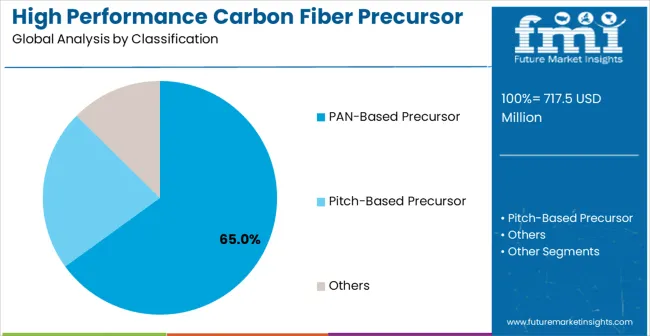
PAN-based carbon fiber precursors account for approximately 65% of the precursor type segment, making them the preferred choice for high-performance applications. These precursors provide consistent fiber quality, high carbon yield, and thermal stability during oxidation and carbonization processes. Leading manufacturers include Toray, Mitsubishi Chemical, Hexcel, and SGL Carbon. PAN-based precursors are widely adopted in aerospace, automotive, and sporting goods due to their superior mechanical properties, enabling the production of lightweight and highly durable composite structures.
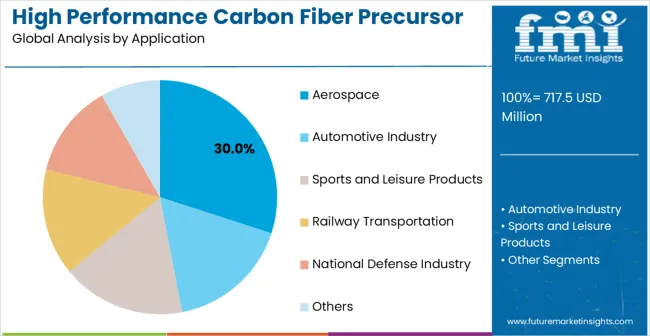
Aerospace applications account for around 30% of the market, representing the largest segment. PAN-based carbon fibers are used in airframes, fuselages, wing structures, and other critical components requiring high strength-to-weight ratios. Suppliers such as Toray, Mitsubishi Chemical, Hexcel, and SGL Carbon provide precursors tailored for aerospace-grade fiber production with consistent tensile properties and low defect rates. Segment growth is driven by increasing aircraft production, adoption of lightweight materials to reduce fuel consumption, and the demand for high-performance structural composites.
The high-performance carbon fiber precursor market is advancing rapidly due to increasing demand for lightweight materials in the aerospace and automotive industries and growing adoption of carbon fiber composites in defense and sports applications that emphasize superior strength-to-weight ratios across various end-use sectors. The market faces challenges, including high production costs associated with advanced precursor manufacturing, limited production capacity among qualified suppliers, and technical complexities in precursor-to-fiber conversion processes. Innovation in cost-effective production methods and capacity expansion continues to influence market development and accessibility patterns.
The growing adoption of carbon fiber precursors in military aircraft, space exploration vehicles, and commercial aviation platforms is enabling manufacturers to develop components that provide exceptional performance characteristics while meeting stringent weight and safety requirements for mission-critical applications. Advanced aerospace applications offer superior design flexibility while allowing more sophisticated structural solutions across various aircraft categories and defense systems. Manufacturers are increasingly recognizing the strategic advantages of high-performance precursor materials for next-generation aerospace platform development and advanced defense system manufacturing.
Modern carbon fiber precursor producers are incorporating environmentally responsible manufacturing processes, energy-efficient production methods, and waste reduction systems to enhance production sustainability while meeting growing environmental compliance requirements from aerospace and automotive customers. These initiatives improve manufacturing efficiency while enabling new applications, including recycled carbon fiber precursors and bio-based precursor alternatives. Advanced sustainability integration also allows producers to support premium market positioning and environmental stewardship commitments beyond traditional precursor manufacturing approaches.
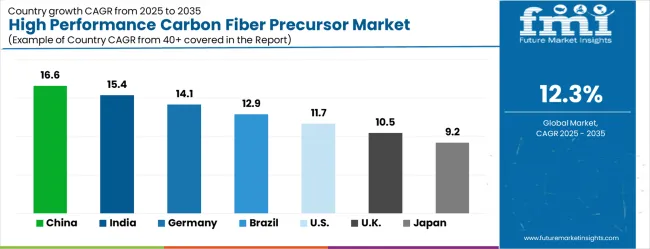
| Country | CAGR (2025-2035) |
|---|---|
| China | 16.6% |
| India | 15.4% |
| Germany | 14.1% |
| Brazil | 12.9% |
| USA | 11.7% |
| UK | 10.5% |
| Japan | 9.2% |
The high-performance carbon fiber precursor market is experiencing exceptional growth globally, with China leading at a 16.6% CAGR through 2035, driven by massive investments in aerospace manufacturing, expanding automotive industry, and government support for advanced materials development. India follows at 15.4%, supported by growing defense modernization programs, expanding aerospace sector, and increasing adoption of lightweight materials in transportation applications. Germany shows growth at 14.1%, emphasizing automotive industry transformation and aerospace engineering excellence. Brazil records 12.9%, focusing on aerospace manufacturing expansion and defense industry development. The USA demonstrates 11.7% growth, prioritizing advanced aerospace programs and defense applications. The UK exhibits 10.5% growth, supported by the strength of the aerospace industry and composite materials innovation. Japan shows 9.2% growth, emphasizing technological advancement and precision manufacturing capabilities.
The report covers an in-depth analysis of 40+ countries, Top-performing countries are highlighted below.
The high-performance carbon fiber precursor market in China is expanding at a CAGR of 16.6%, well above the global average of 13%. Growth is fueled by the aerospace, automotive, and wind energy sectors, which demand lightweight, high-strength composites. Industrial clusters deploy carbon fiber precursors to produce advanced composite materials for aircraft structures, high-performance vehicles, and wind turbine blades. Pilot programs demonstrate improved tensile strength, thermal stability, and production efficiency. Suppliers focus on scalable, high-purity precursor production and advanced stabilization techniques. Government initiatives supporting advanced materials, green energy, and industrial innovation further accelerate adoption. Research collaborations with aerospace and automotive firms drive technological advances in carbon fiber manufacturing.
India is projected to grow at a CAGR of 15.4%, above the global average. Growth is driven by expanding aerospace, automotive, and defense industries requiring advanced composite materials. High-performance carbon fiber precursors are deployed in vehicle chassis, aircraft components, and renewable energy equipment. Industrial clusters implement optimized production techniques to improve precursor quality and mechanical properties. Pilot programs demonstrate higher fiber strength and thermal stability. Suppliers provide cost-effective and scalable solutions for large-scale applications. Domestic investment in aerospace and automotive manufacturing supports gradual market expansion.
Germany grows at a CAGR of 14.1%, above the global average. Growth is LED by automotive, aerospace, and industrial machinery sectors demanding lightweight and high-strength composites. High-performance carbon fiber precursors are used for structural components, wind turbine blades, and high-performance automotive parts. Suppliers focus on energy-efficient and high-purity production systems. Pilot installations demonstrate improved fiber consistency, tensile strength, and thermal properties. Industrial clusters adopt automated production lines to reduce cycle times and improve product quality. R&D efforts focus on optimizing precursor stabilization, carbonization, and composite integration processes.
The Brazilian market grows at a CAGR of 12.9%, slightly below the global average. Growth is supported by aerospace, automotive, and renewable energy sectors adopting carbon fiber composites. High-performance precursors are deployed in aircraft components, vehicle frames, and wind energy equipment to improve strength and reduce weight. Suppliers provide robust, scalable systems suitable for industrial-scale production. Pilot programs demonstrate optimized production efficiency and enhanced material performance. Increasing investment in renewable energy, industrial projects, and aerospace research drives adoption. Local distributors offer technical support for composite fabrication and quality control.
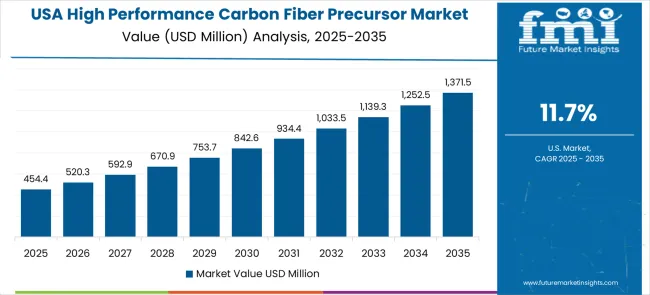
The United States grows at a CAGR of 11.7%, slightly below the global average. Growth is influenced by a mature aerospace and defense sector with established composite material technologies. High-performance carbon fiber precursors are applied in aircraft structures, defense vehicles, and automotive composites. Suppliers provide advanced, energy-efficient production systems for high-purity precursors. Pilot programs demonstrate enhanced tensile strength, thermal stability, and reduced cycle times. Industrial clusters integrate precursors into automated composite manufacturing lines. R&D initiatives focus on improving precursor properties, carbonization efficiency, and composite integration.
The UK market grows at a CAGR of 10.5%, below the global average. Slower growth reflects a mature aerospace, automotive, and renewable energy sector with established composite production. High-performance carbon fiber precursors are used in aircraft components, automotive parts, and wind turbine blades. Suppliers provide high-purity, durable, and energy-efficient precursor systems. Pilot installations demonstrate improved material consistency, thermal stability, and tensile strength. Industrial clusters adopt automated production lines for efficient precursor synthesis. Research initiatives aim to improve energy efficiency, carbonization processes, and precursor integration in advanced composites.
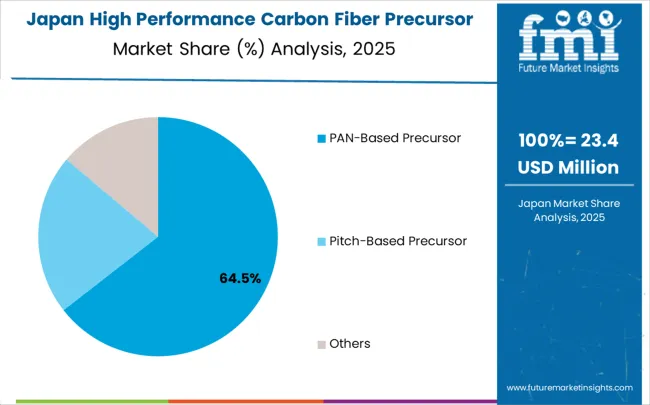
Japan grows at a CAGR of 9.2%, below the global average. Slower growth is influenced by a mature composite industry with advanced production capabilities. High-performance carbon fiber precursors are applied in aerospace, automotive, and electronics sectors for lightweight and high-strength components. Suppliers provide reliable, energy-efficient, and precise production systems. Pilot programs demonstrate improved fiber quality, thermal stability, and mechanical properties. Industrial clusters integrate precursors into automated composite manufacturing lines. R&D initiatives focus on optimizing stabilization, carbonization, and composite fabrication techniques for high-performance applications.
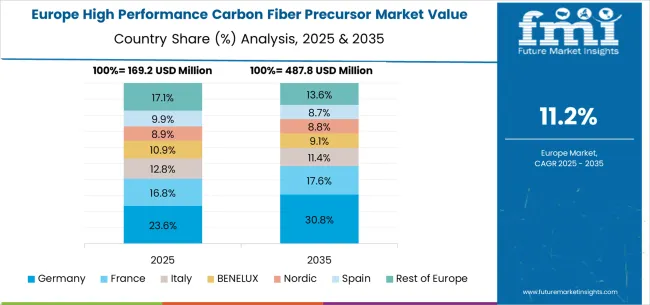
The high-performance carbon fiber precursor market in Europe is projected to grow from USD 180.2 million in 2025 to USD 570.3 million by 2035, registering a CAGR of 12.2% over the forecast period. Germany is expected to maintain its leadership position with a 32.1% market share in 2025, declining slightly to 31.5% by 2035, supported by its advanced automotive industry transformation, aerospace engineering excellence, and comprehensive composite materials manufacturing capabilities.
The United Kingdom follows with a 24.0% share in 2025, projected to reach 23.8% by 2035, driven by aerospace industry strength, advanced composite materials research, and its established position in global aerospace supply chains serving both commercial and defense applications. France holds an 18.5% share in 2025, expected to maintain 18.7% by 2035, supported by aerospace manufacturing capabilities and growing adoption in transportation applications. Italy commands a 12.2% share in 2025, projected to reach 12.5% by 2035, while Spain accounts for 8.1% in 2025, expected to reach 8.3% by 2035. The Rest of Europe region, including Nordic countries, Eastern Europe, the Netherlands, Belgium, Switzerland, and Austria, is anticipated to hold 5.1% in 2025, growing to 5.2% by 2035, attributed to increasing adoption of advanced materials in emerging aerospace and automotive applications across smaller European markets implementing advanced manufacturing programs.
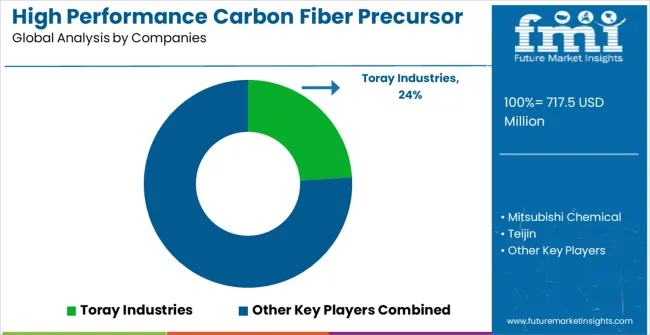
The high-performance carbon fiber precursor market is characterized by competition among established chemical companies, specialized precursor manufacturers, and integrated carbon fiber producers. Companies are investing in advanced production technologies, quality enhancement systems, capacity expansion programs, and comprehensive research and development initiatives to deliver consistent, high-performance, and cost-effective precursor materials. Innovation in PAN and pitch-based precursor technologies, sustainable production methods, and application-specific product development is central to strengthening market position and customer relationships.
Toray Industries leads the market with a strong focus on technological innovation and integrated carbon fiber production, offering comprehensive precursor solutions that emphasize quality consistency and performance optimization. Mitsubishi Chemical provides advanced precursor technologies with a focus on aerospace applications and global manufacturing capabilities. Teijin delivers specialized precursor materials with a focus on automotive and industrial applications. Hexcel Corporation focuses on aerospace-grade precursor materials with emphasis on performance excellence and certification compliance. SGL Carbon emphasizes sustainable production methods with a focus on European markets and automotive applications. Hyosung provides cost-effective precursor solutions with a focus on Asian markets and industrial applications.
| Items | Values |
|---|---|
| Quantitative Units (2025) | USD 717.5 million |
| Precursor Type | PAN-Based Precursor, Pitch-Based Precursor, Others |
| Application | Aerospace, Automotive Industry, Sports and Leisure Products, Railway Transportation, National Defense Industry, Others |
| Regions Covered | North America, Europe, East Asia, South Asia & Pacific, Latin America, Middle East & Africa |
| Countries Covered | United States, Canada, United Kingdom, Germany, France, China, Japan, South Korea, India, Brazil, Australia and 40+ countries |
| Key Companies Profiled | Toray Industries, Mitsubishi Chemical, Teijin, Hexcel Corporation, SGL Carbon, Hyosung, AKSA, Kemrock, Advanced Connection Technology, Jilin Carbon Valley, Runjust Carbon, and Jiangsu Hengshen |
| Additional Attributes | Dollar sales by precursor type and application, regional demand trends, competitive landscape, technological advancements in precursor production, sustainable manufacturing initiatives, quality standardization programs, and capacity expansion strategies |
The global high performance carbon fiber precursor market is estimated to be valued at USD 717.5 million in 2025.
The market size for the high performance carbon fiber precursor market is projected to reach USD 2,288.8 million by 2035.
The high performance carbon fiber precursor market is expected to grow at a 12.3% CAGR between 2025 and 2035.
The key product types in high performance carbon fiber precursor market are pan-based precursor, pitch-based precursor and others.
In terms of application, aerospace segment to command 30.0% share in the high performance carbon fiber precursor market in 2025.






Our Research Products

The "Full Research Suite" delivers actionable market intel, deep dives on markets or technologies, so clients act faster, cut risk, and unlock growth.

The Leaderboard benchmarks and ranks top vendors, classifying them as Established Leaders, Leading Challengers, or Disruptors & Challengers.

Locates where complements amplify value and substitutes erode it, forecasting net impact by horizon

We deliver granular, decision-grade intel: market sizing, 5-year forecasts, pricing, adoption, usage, revenue, and operational KPIs—plus competitor tracking, regulation, and value chains—across 60 countries broadly.

Spot the shifts before they hit your P&L. We track inflection points, adoption curves, pricing moves, and ecosystem plays to show where demand is heading, why it is changing, and what to do next across high-growth markets and disruptive tech

Real-time reads of user behavior. We track shifting priorities, perceptions of today’s and next-gen services, and provider experience, then pace how fast tech moves from trial to adoption, blending buyer, consumer, and channel inputs with social signals (#WhySwitch, #UX).

Partner with our analyst team to build a custom report designed around your business priorities. From analysing market trends to assessing competitors or crafting bespoke datasets, we tailor insights to your needs.
Supplier Intelligence
Discovery & Profiling
Capacity & Footprint
Performance & Risk
Compliance & Governance
Commercial Readiness
Who Supplies Whom
Scorecards & Shortlists
Playbooks & Docs
Category Intelligence
Definition & Scope
Demand & Use Cases
Cost Drivers
Market Structure
Supply Chain Map
Trade & Policy
Operating Norms
Deliverables
Buyer Intelligence
Account Basics
Spend & Scope
Procurement Model
Vendor Requirements
Terms & Policies
Entry Strategy
Pain Points & Triggers
Outputs
Pricing Analysis
Benchmarks
Trends
Should-Cost
Indexation
Landed Cost
Commercial Terms
Deliverables
Brand Analysis
Positioning & Value Prop
Share & Presence
Customer Evidence
Go-to-Market
Digital & Reputation
Compliance & Trust
KPIs & Gaps
Outputs
Full Research Suite comprises of:
Market outlook & trends analysis
Interviews & case studies
Strategic recommendations
Vendor profiles & capabilities analysis
5-year forecasts
8 regions and 60+ country-level data splits
Market segment data splits
12 months of continuous data updates
DELIVERED AS:
PDF EXCEL ONLINE
High-Performance Fiber Market Size and Share Forecast Outlook 2025 to 2035
High-Performance Fibers for Defense Market Report – Demand, Trends & Industry Forecast 2025 to 2035
High Performance Permanent Magnet Market Size and Share Forecast Outlook 2025 to 2035
High Performance Liquid Chromatography-Tandem Mass Spectrometry System Market Size and Share Forecast Outlook 2025 to 2035
High-performance Dual-core Processor Market Size and Share Forecast Outlook 2025 to 2035
High Performance Magnet Market Size and Share Forecast Outlook 2025 to 2035
High Performance Random Packing Market Forecast Outlook 2025 to 2035
High Performance Composites Market Forecast Outlook 2025 to 2035
High Performance Medical Plastic Market Forecast Outlook 2025 to 2035
High Performance Epoxy Coating Market Size and Share Forecast Outlook 2025 to 2035
High Performance Fluoropolymer Market Size and Share Forecast Outlook 2025 to 2035
High Performance Mercury Sorbent Market Size and Share Forecast Outlook 2025 to 2035
High-performance Electric Sports Cars Market Size and Share Forecast Outlook 2025 to 2035
High-Performance Computing Market Size and Share Forecast Outlook 2025 to 2035
High Performance Polyamides Market Size and Share Forecast Outlook 2025 to 2035
High Performance Data Analytics (HPDA) Market Size and Share Forecast Outlook 2025 to 2035
High Performance Pigments Market Size and Share Forecast Outlook 2025 to 2035
High Performance Trucks Market Size and Share Forecast Outlook 2025 to 2035
High Performance Barrier Films Market Size, Growth, and Forecast 2025 to 2035
High Performance Message Infrastructure Market Size, Growth, and Forecast 2025 to 2035

Thank you!
You will receive an email from our Business Development Manager. Please be sure to check your SPAM/JUNK folder too.
Chat With
MaRIA